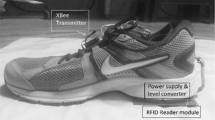Abstract
The article presents selected aspects related to the implementation of RFID readers in a mobile robot that tests a given surface. The advantages of such a solution are given, which significantly improves the accuracy of the location. Issues related to energy flow in RFID systems are discussed, including inductive and propagation coupling. Details on software handling of multiple RFID readers are given. Test results of two modes of operation are presented, i.e. using polling and interrupts. The algorithm for reader prioritization is also shown.
Access this chapter
Tax calculation will be finalised at checkout
Purchases are for personal use only
Similar content being viewed by others
References
Finkenzeller, K.: RFID Handbook, 3rd edn. Wiley, New York (2010)
ISO/IEC 15693. Identification cards - Contactless integrated circuit cards - Vicinity cards
ISO/IEC 14443-3. Identification cards - Contactless integrated circuit cards - Proximity cards (2016)
Sanpechuda, T., Kovavisaruch, L.: A review of RFID localization: applications and techniques. In: 5th International Conference on Electrical Engineering/Electronics, Computer, Telecommunications and Information Technology, May 2008, pp. 769–772 (2008)
Jian, M.-S., Wu, J.-S.: RFID applications and challenges. In: Radio Frequency Identification from System to Applications. InTech, Vienna (2013)
Willis, S., Helal, S.: RFID information grid for blind navigation and wayfinding. In: Ninth IEEE International Symposium on Wearable Computers (ISWC 2005), October 2005, pp. 34–37 (2005)
Lionel, M.N., Liu, Y., Lau, Y.C., Patil, A.P.: LANDMARC: indoor location sensing using active RFID. Wirel. Netw. 10(6), 701–710 (2004)
Subramanian, S.P., Sommer, J., Schmitt, S., Rosenstiel, W.: RIL - reliable RFID based indoor localization for pedestrians. In: 16th International Conference on Software, Telecommunications and Computer Networks, September 2008, pp. 218–222 (2008)
Chia-Yu, Y., Wei-Chun, H.: An indoor positioning system based on the dual-channel passive RFID technology. IEEE Sens. J. 18(11), 4654 (2018)
Pomárico-Franquiz, J.J., Shmaliy, Y.S.: Accurate self-localization in RFID tag information grids using FIR filtering. IEEE Trans. Ind. Inform. 10(2), 1317 (2014)
Soltani, M.M., Motamedi, A., Hammad, A.: Enhancing cluster-based RFID tag localization using artificial neural networks and virtual reference tags. In: 2013 International Conference on Indoor Positioning and Indoor Navigation, 28–31 October 2013
Han-Yen, Y., Jiann-Jone, C., Tien-Ruey, H.: Design and implementation of a real-time object location system based on passive RFID tags. IEEE Sens. J. 15(9), 5015 (2015)
Zhou, J., Shi, J.: RFID localization algorithms and applications - a review. J. Intell. Manuf. 20(6), 695–707 (2009)
Saab, S.S., Nakad, Z.S.: A standalone RFID indoor positioning system using passive tags. IEEE Trans. Ind. Electron. 58(5), 1961–1970 (2011)
Han, S., Lim, H., Lee, J.: An efficient localization scheme for a differential-driving mobile robot based on RFID system. IEEE Trans. Ind. Electron. 54(6), 3362–3369 (2007)
Deyle, T., Nguyen, H., Reynolds, M.S., Kemp, C.C.: RFID-guided robots for pervasive automation. IEEE Pervasive Comput. 9(2), 37–45 (2010)
Boccadoro, M., Martinelli, F., Pagnotelli, S.: Constrained and quantized Kalman filtering for an RFID robot localization problem. Auton. Robots 29(3–4), 235–251 (2010)
DiGiampaolo, E., Martinelli, F.: Mobile robot localization using the phase of passive UHF-RFID signals. IEEE Trans. Ind. Electron. 61(1), 365–376 (2014)
Gueaieb, W., Miah, M.S.: An intelligent mobile robot navigation technique using RFID technology. IEEE Trans. Instrum. Meas. 57(9), 1908–1917 (2008)
Choi, B.S., Lee, J.W., Lee, J.J., Park, K.T.: A hierarchical algorithm for indoor mobile robot localization using RFID sensor fusion. IEEE Trans. Ind. Electron. 58(6), 2226–2235 (2011)
DiGiampaolo, E., Martinelli, F.: A passive UHF-RFID system for the localization of an indoor autonomous vehicle. IEEE Trans. Ind. Electron. 59(10), 3961–3970 (2012)
Papapostolou, A., Chaouchi, H.: RFID-assisted indoor localization and the impact of interference on its performance. J. Netw. Comput. Appl. 34(3), 902–913 (2011)
Hubacz, M., Pawlowicz, B., Trybus, B.: Exploring a surface using RFID grid and group of mobile robots. In: Szewczyk, R., Zieliński, C., Kaliczyńska, M. (eds.) Automation 2018 Advances in Automation, Robotics and Measurement Techniques. Advances in Intelligent Systems and Computing, vol. 743, pp. 490–499. Springer (2018)
Jankowski-Mihułowicz, P., Węglarski, M.: Determination of 3-dimentional interrogation zone in anticollision RFID systems with inductive coupling by using Monte Carlo method. Acta Phys. Pol. A 121(4), 936–940 (2012)
Jankowski-Mihułowicz, P., Kalita, W., Pawłowicz, B.: Problem of dynamic change of tags location in anticollision RFID systems. Microelectron. Reliab. 48(6), 911–918 (2008). https://doi.org/10.1016/j.microrel.2008.03.006
IEC 61000-6-3 Electromagnetic Compatibility - Part 6-3: Generic Standards - Emission Standard For Residential, Commercial And Light-industrial Environments
Wang, J., Wang, D., Zhao, Y., Korhonen, T.: Fast anti-collision algorithms in RFID systems. In: International Conference on Mobile Ubiquitous Computing, Systems, Services and Technologies - UBICOMM 2007, 4–9 November 2007, pp. 75–80 (2007)
Jia, L., Bin, X., Xuan, L., Lijun, C.: Fast RFID polling protocols. In: 45th International Conference on Parallel Processing (ICPP). https://doi.org/10.1109/icpp.2016.42. Accessed 16–19 Aug 2016. ISBN 978-1-5090-2823-8
Liu, J., Po, Y.: A Localization algorithm for mobile robots in RFID system. In: 2007 International Conference on Wireless Communications, Networking and Mobile Computing (2007). https://doi.org/10.1109/wicom.2007.527. Accessed 21–25 Sept 2007. ISBN 1-4244-1311-7
MFRC522 Standard performance MIFARE and NTAG frontend, NXP Semiconductors. https://www.nxp.com/docs/en/data-sheet/MFRC522.pdf
Acknowledgment
Results of Grant No. PBS1/A3/3/2012 from Polish National Centre for Research and Development as well as Statutory Activity of Rzeszow University of Technology were applied in this work. The work was developed by using equipment purchased in Operational Program Development of Eastern Poland 2007–2013, Priority Axis I Modern Economics, Activity I.3 Supporting Innovation under Grant No. POPW.01.03.00-18-012/09-00 as well as Program of Development of Podkarpacie Province of European Regional Development Fund under Grant No. UDA-RPPK.01.03.00-18-003/10-00.
Author information
Authors and Affiliations
Corresponding authors
Editor information
Editors and Affiliations
Rights and permissions
Copyright information
© 2020 Springer Nature Switzerland AG
About this paper
Cite this paper
Hubacz, M., Pawłowicz, B., Trybus, B. (2020). Using Multiple RFID Readers in Mobile Robots for Surface Exploration. In: Szewczyk, R., Zieliński, C., Kaliczyńska, M. (eds) Automation 2019. AUTOMATION 2019. Advances in Intelligent Systems and Computing, vol 920. Springer, Cham. https://doi.org/10.1007/978-3-030-13273-6_42
Download citation
DOI: https://doi.org/10.1007/978-3-030-13273-6_42
Published:
Publisher Name: Springer, Cham
Print ISBN: 978-3-030-13272-9
Online ISBN: 978-3-030-13273-6
eBook Packages: Intelligent Technologies and RoboticsIntelligent Technologies and Robotics (R0)




